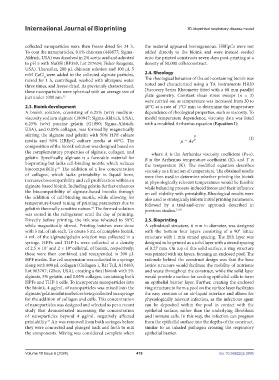Page 418 - IJB-10-6
P. 418
International Journal of Bioprinting 3D-bioprinted respiratory disease model
collected nanoparticles were then freeze-dried for 24 h. the material appeared homogeneous. HBEpCs were not
To coat the nanoparticles, 0.1% chitosan (448877; Sigma- added directly to the bioink and were instead seeded
Aldrich, USA) was dissolved in 2% acetic acid and adjusted onto the printed constructs seven days post-printing at a
to pH 5 with NaOH (BP359, Lot 217634; Fisher Reagents, density of 50,000 cells/construct.
USA). Thereafter, 200 µL chitosan solution and 100 µL 5
mM CaCl were added to the collected alginate particles, 2.4. Rheology
2
mixed for 1 h, centrifuged, washed with ultrapure water The rheological behavior of the cell-containing bioink was
three times, and freeze-dried. As previously characterized, tested and characterized using a TA Instruments HR20
these nanoparticles were spherical with an average size of Discovery Series Rheometer fitted with a 60 mm parallel
just under 1000 nm. 33 plate geometry. Constant shear stress sweeps (n = 3)
were carried out as temperature was increased from 20 to
2.3. Bioink development 40°C at a rate of 1°C/ min to determine the temperature
A bioink solution, consisting of 6.25% (w/v) medium- dependence of rheological properties, such as viscosity. To
viscosity sodium alginate (180947; Sigma-Aldrich, USA), model temperature dependence, viscosity data was fitted
6.25% (w/v) porcine gelatin (G1890; Sigma-Aldrich, with a modified Arrhenius equation (Equation I):
USA), and 0.05% collagen, was formed by magnetically
stirring the alginate and gelatin with 50% HPF culture B
media and 50% HBEpC culture media at 60°C. The µ = Ae T (I)
composition of the bioink solution was designed based on
the complementary properties of alginate, collagen, and where A is the Arrhenius viscosity coefficient (Pa∙s),
gelatin. Specifically, alginate is a favorable material for B is the Arrhenius temperature coefficient (K), and T is
bioprinting but lacks cell-binding motifs, which reduces the temperature (K). The modified equation describes
biocompatibility. The addition of a low concentration viscosity as a function of temperature. The obtained results
45
of collagen, which lacks printability in liquid form, were then used to determine whether printing the bioink
increases biocompatibility and cell proliferation within an at physiologically relevant temperatures would be feasible
alginate-based bioink. Including gelatin further enhances while balancing process-induced forces and their influence
the biocompatibility of alginate-based bioinks through on cell viability with printability. Rheological results were
the addition of cell-binding motifs, while allowing for also used to strategically inform initial printing parameters,
temperature-based tuning of printing parameters due to followed by a trial-and-error approach described in
45
gelatin’s thermally sensitive nature. The formed solution previous studies. 33,45
was stored in the refrigerator until the day of printing.
Directly before printing, the ink was reheated to 50°C 2.5. Bioprinting
while magnetically stirred. Printing batches were done A cylindrical structure, 6 mm in diameter, was designed
with 5 mL of ink each. To create 5 mL of complete bioink, with the bottom four layers consisting of a 90° lattice
4 mL of the alginate/gelatin solution was collected in a structure with 1 mm strand spacing. The fifth layer was
syringe. HPFs and THP-1s were collected at a density designed to be printed as a solid layer with a strand spacing
of 2.5 × 10 and 2 × 10 cells/mL of bioink, respectively; of 0.27 mm. On top of this solid surface, a ring structure
7
6
these were then combined and resuspended in 200 µL was printed with six layers, forming an enclosed pool. The
HPF media. The cell suspension was collected in a syringe rationale behind the construct design was that the base
along with 800 µL collagen (Collagen 1, Rat Tail, A10483, lattice structure would facilitate the mobility of nutrients
Lot 963787; Gibco, USA), creating a final bioink with 5% and waste throughout the construct, while the solid layer
alginate, 5% gelatin, and 0.05% collagen, containing both would provide a surface for seeding epithelial cells to form
HPFs and THP-1 cells. To incorporate nanoparticles into an epithelial barrier layer. Further, creating the enclosed
the bioink, 4 µg/mL of nanoparticles was mixed into the ring structure to form a pool on the surface layer facilitates
alginate/gelatin solution before being collected in a syringe the easy creation of an air-liquid interface and allows for
for the addition of collagen and cells. This concentration physiologically relevant infection, as the infectious agent
of nanoparticles was designed and selected as per a recent can be deposited within the pool in contact with the
study that demonstrated increasing the concentration epithelial surface, rather than the underlying fibroblasts
of nanoparticles beyond 4 µg/mL negatively affected and immune cells. In this way, the infection can progress
printability. Air was removed from both syringes before from the epithelial surface into the depths of the construct,
33
they were connected and plunged back and forth to mix similar to an inhaled pathogen crossing the respiratory
the components. Mixing was considered complete when epithelial barrier.
Volume 10 Issue 6 (2024) 410 doi: 10.36922/ijb.3895

